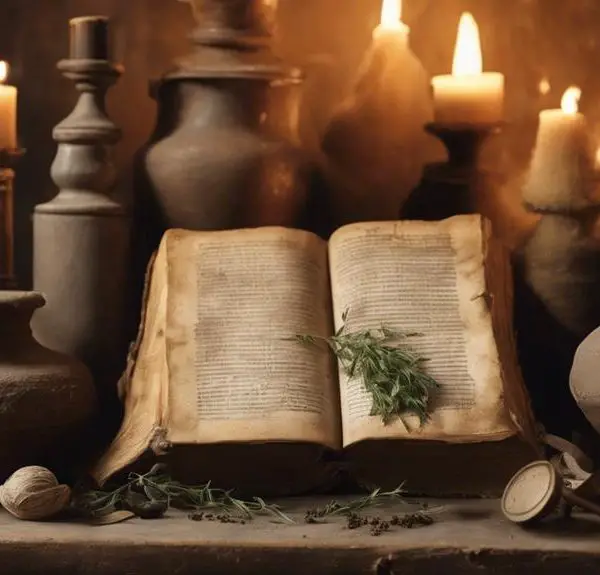Delve into a journey of understanding the Bible, exploring how translation, culture, and personal faith influence your perception of its sacred verses.

Apprehended Meaning in the Bible
Like a miner sifting through a rich vein of ore, you're constantly seeking to unearth the deeper significance hidden within the pages of the Bible.
But have you ever paused to consider how your apprehension of its meaning might be influenced by factors like translation variations, cultural differences, or your personal faith?
As you continue in your quest for understanding, you might find it intriguing to explore how these elements can transform your perception of this sacred text.
What revelations might await in this uncharted territory of spiritual exploration?
Key Takeaways
- Contextual understanding, including historical, cultural, and authorial aspects, is key to interpreting biblical meanings.
- Translation variations, influenced by language and potential biases, can significantly alter biblical interpretation.
- Cultural knowledge from biblical times aids in deciphering symbolism and societal norms depicted in the scriptures.
- Personal faith evolution and spiritual experiences shape individual comprehension and application of biblical teachings.
The Role of Context in Interpretation

To fully grasp the profound meanings concealed within the Bible, you must first understand the vital role context plays in interpretation. Contextual clarity isn't just about understanding the historical or cultural backdrop of the Bible. It's about delving deeper into the text, to comprehend the author's intent, to grasp the recipients' situation, and to appreciate the peculiarities of the original language.
The interpretive principles that govern biblical exegesis stress the importance of context. It's not enough to read a verse in isolation. You need to consider its position within the broader narrative, its relationship to surrounding verses, and its place within the overarching themes of the Bible. You're not just interpreting words, you're interpreting a message embedded within a larger story.
Contextual interpretation also requires you to consider genre. The Bible contains poetry, law, narrative, prophecy, and wisdom literature. Each genre has its conventions and requires specific interpretive approaches. Misapplying genre rules can lead to misguided interpretations.
Influence of Translation Variations

While understanding context is crucial, you also have to account for the fact that different translations of the Bible can significantly impact its interpretation. This is where translation precision and the nuances of Biblical languages come into play.
Even though the original texts were written in Hebrew, Aramaic, and Greek, the Bible has been translated into numerous languages over the centuries. Each translation brings its own set of variations that can subtly or drastically change the meaning of the text. What's more, the translators' cultural and theological biases can also affect the final interpretation.
To illustrate this, let's look at a simple comparison of two English translations:
Verse |
King James Version |
New International Version |
|---|---|---|
Genesis 1:1 |
"In the beginning God created the heaven and the earth." |
"In the beginning God created the heavens and the earth." |
John 3:16 |
"For God so loved the world, that he gave his only begotten Son…" |
"For God so loved the world that he gave his one and only Son…" |
Psalm 23:4 |
"Yea, though I walk through the valley of the shadow of death…" |
"Even though I walk through the darkest valley…" |
Matthew 5:3 |
"Blessed are the poor in spirit…" |
"Blessed are the poor in spirit…" |
As you can see, even in the same language, the translation variations can lead to different interpretations and hence, the apprehended meaning of the Bible.
Understanding Cultural Differences

Understanding cultural differences is another crucial aspect you need to consider when interpreting the Bible, as the texts were written in vastly different societal contexts than our own. That's where the understanding of cultural symbolism and historical backgrounds becomes instrumental.
Cultural symbolism, embedded in biblical narratives, often reflects ancient societies' beliefs and practices. For example, you'll find symbols like water, bread, and vine, which held specific meanings in the cultures of that time. Recognizing these symbols within their historical context will aid in your understanding of biblical messages.
You also can't overlook the importance of historical backgrounds. The societies in which biblical texts were written had different norms, laws, and customs. It's important to grasp these realities to fully comprehend the texts. For instance, understanding the societal structure in ancient Israel or the Roman Empire's political climate can shed light on the context of certain biblical passages.
Personal Faith and Scripture Comprehension

Your personal faith acts as a prism through which you interpret and comprehend biblical scriptures, shaping your understanding and interpretation of its messages. It's a dynamic, ongoing process, deeply intertwined with your 'Faith Evolution.' As you grow and mature, both personally and spiritually, your faith evolves. Consequently, this evolution influences how you understand and apply biblical teachings to your daily life.
'Spiritual Revelation' is another critical aspect of scripture comprehension. It refers to those moments when a particular passage or concept in the Bible suddenly becomes clear or takes on a new, profound meaning. These revelations can significantly impact your faith, leading to deeper understanding and greater conviction.
However, it's important to remember that personal faith and scripture comprehension isn't a one-size-fits-all process. Each individual's faith journey is unique, with diverse experiences and understandings that shape their interpretation of the Bible. Scripture comprehension, thus, is a highly personal endeavor, shaped by the steady evolution of faith and punctuated by moments of spiritual revelation. This makes the Bible a living, dynamic text, constantly interacting with and being shaped by your evolving faith.
Navigating Ambiguities in the Bible

Navigating the inherent ambiguities in the Bible can be a complex endeavor, requiring a keen sense of discernment and a deep understanding of historical, cultural, and linguistic contexts. You'll need to be familiar with the art of interpreting parables, a common literary device used in the Bible, where a simple story is used to illustrate a moral or spiritual lesson.
Symbolic language usage is another aspect to consider. Symbols in biblical texts often carry profound meanings that transcend the literal interpretation. For instance, 'bread' can symbolize sustenance or the word of God, while 'water' often stands for the spirit or life. Hence, you need to discern not just the literary meaning but also the symbolic connotations.
Beyond just the words, it's crucial to understand the historical and cultural backdrop of the biblical times. Certain practices or customs, which might seem obscure to us, were commonplace then and provide context to the scriptures.
Frequently Asked Questions
How Does the Bible's Historical Timeline Correlate With Modern Scientific Findings?
You're exploring the correlation between the Bible's historical timeline and modern scientific findings. It's a complex task, one where Biblical cosmology and archaeological evidence come into play.
While some biblical events align with archaeological findings, others don't. There's also the challenge of interpreting ancient texts in a modern scientific context.
What Are the Main Differences Between the Old Testament and the New Testament?
When comparing the Old and New Testaments, you'll find key differences. The Old Testament primarily focuses on the Mosaic Covenant, emphasizing law and obedience.
The New Testament introduces the New Covenant, emphasizing grace and faith. Testament themes vary: the Old Testament contains prophecies and histories, while the New Testament offers fulfillment of these prophecies and teachings of Christ.
Understanding these differences helps you grasp the Bible's comprehensive message.
How Can One Reconcile Contradicting Verses in the Bible?
To reconcile contradicting verses in the Bible, you'll need to understand verse contextualization and biblical parables. It's not just what's said, but where, when, and why it's said.
You're dealing with parables and complex metaphors, which aren't meant to be literal. Delve into the historical, cultural context of the verses. Remember, the Bible is a collection of books written across centuries by different authors.
Interpretation isn't always black and white.
What Is the Significance of the Different Authors of the Bible's Books?
The different authors of the Bible's books each had their own authorial intent, influenced by their cultural context. You must understand these to fully grasp the text.
Some authors aimed to provide historical accounts, while others shared prophetic visions or moral teachings. Their backgrounds, perspectives, and purposes vary, adding depth and complexity to the Bible.
It's not merely about the words on the page, but the people and circumstances behind them.
How Has the Interpretation of the Bible Evolved Over Time in Different Religious Denominations?
You've observed how the interpretation of the Bible has evolved over time, influenced by cultural shifts and denominational diversity. Different religious groups, influenced by their unique cultural contexts, have developed varying interpretations.
These interpretations have evolved, reflecting changes in societal norms and beliefs. It's a testament to the Bible's enduring relevance that its meaning continues to be reinterpreted in light of changing cultural and denominational perspectives.
Conclusion
In understanding the Bible, you must delve deeper than surface text. The context is critical, as it shapes interpretation. Consider translation variations and cultural differences that can alter meanings.
Your personal faith also plays a role in comprehension. Ambiguities, though challenging, aren't insurmountable. Ultimately, the Bible's apprehended meaning is a complex blend of these elements, requiring an analytical, informed approach to truly unlock its profound wisdom.



Sign up